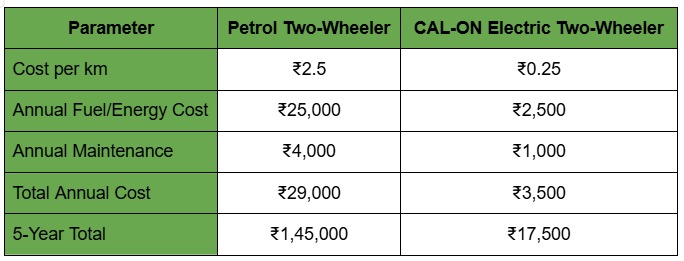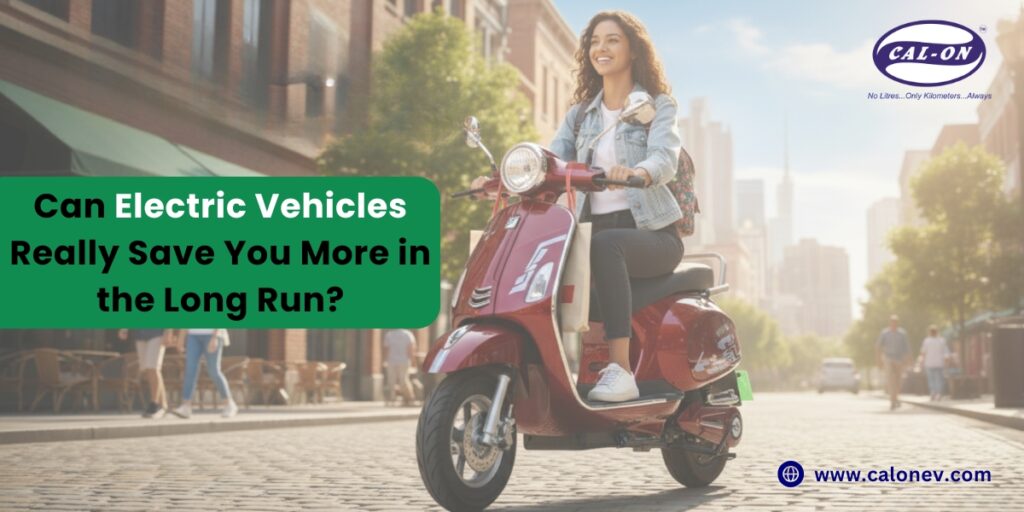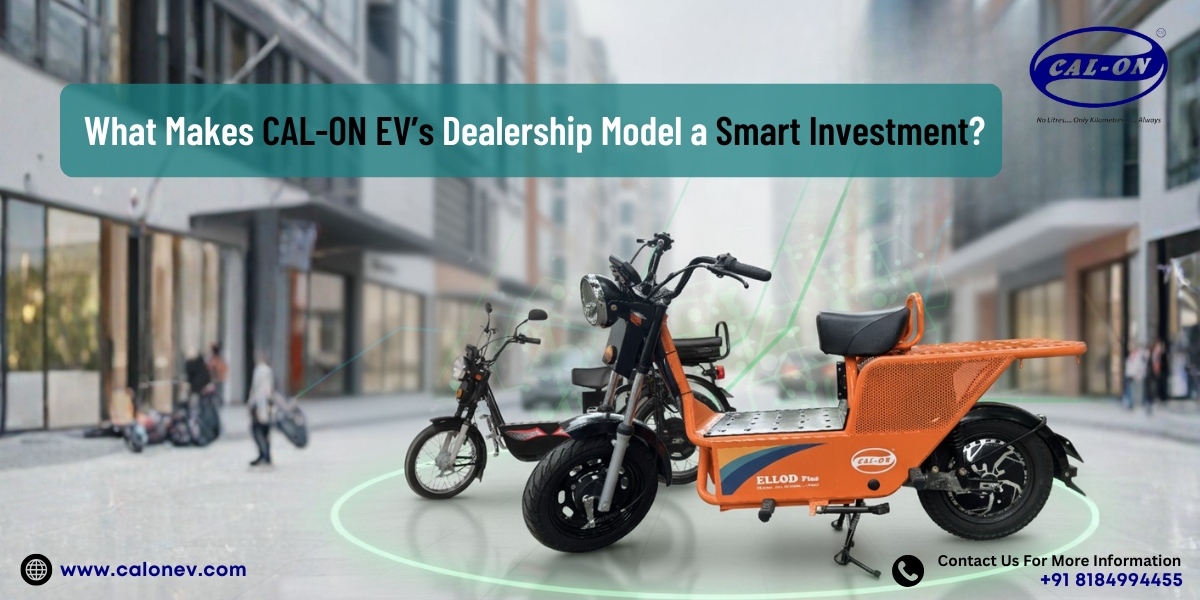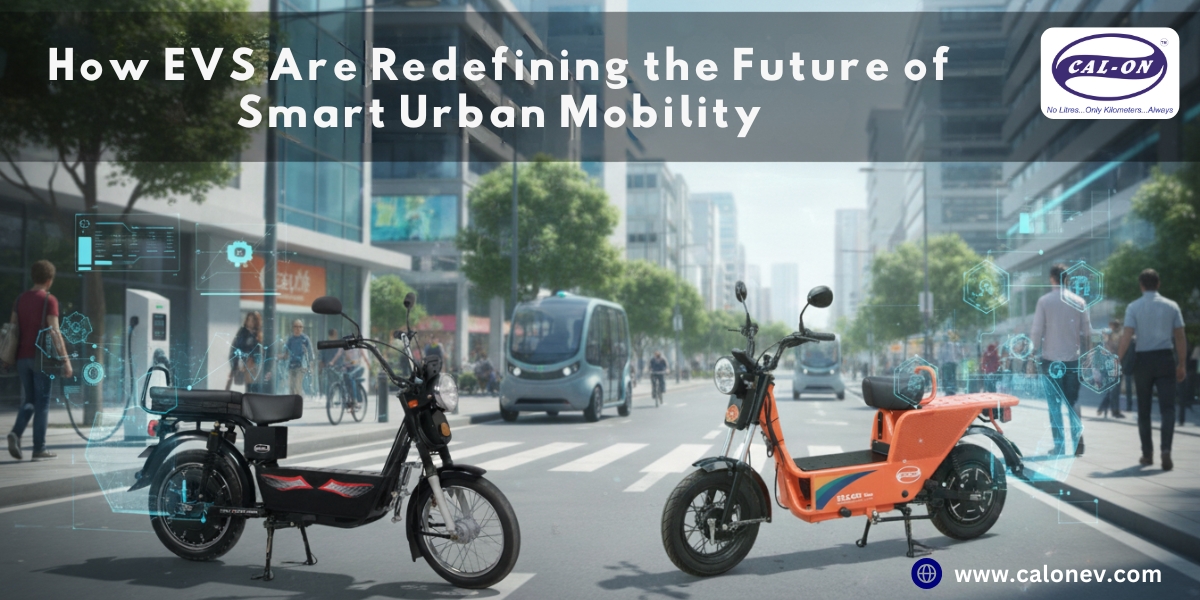The Real Picture of Electric Vehicles’ Savings
When it comes to modern mobility, one question stands out: Can Electric Vehicles (EVs) really save you more in the long run? At CAL-ON EV, we’ve built our vision around this very question. As fuel prices continue to rise and environmental concerns deepen, Electric Vehicle Savings have become more than just a topic of discussion – they’re now a proven reality for thousands of Indian riders who have made the switch.
From lower running costs to reduced maintenance and government incentives, electric vehicle cost savings are transforming the way India commutes. Whether it’s a delivery fleet in Hyderabad or an everyday commuter in Mumbai, the numbers clearly show that the long-term benefits of electric vehicles far outweigh traditional petrol-based models.
Let’s take a closer look at how much you can save with an electric vehicle, what factors drive these savings, and why CAL-ON EV believes that the future of mobility is not just electric – it’s economical too.
Why Electric Vehicle Savings Are More Real Than Ever
The most common myth we hear is – “EVs are expensive.” But the truth is, EV vs petrol vehicle cost comparison tells a very different story when you consider long-term ownership.
While the initial cost of an EV may seem slightly higher than a petrol scooter, the EV running cost in India is drastically lower. With electricity costing just around ₹1.5 – ₹2 per unit, and EVs running an average of 80 – 100 km per full charge, your cost per kilometre drops to just 20 – 25 paise, compared to ₹2 – 3 per km for petrol vehicles.
That means every 10,000 km you ride, you could be saving between ₹18,000 to ₹25,000 – and that’s just on fuel.
Add to that electric vehicle maintenance cost – which is nearly 60 – 70% lower than a petrol engine – and the total electric vehicle cost savings over 3 – 5 years can easily cross ₹75,000 to ₹1,00,000.
At CAL-ON EV, we’ve designed our range – including models like Elacil 2.5, Ellod Plus, and Velocil EH – to deliver maximum performance with minimum operating expense, ensuring that riders feel the impact of these savings every single day.
The Long-Term Benefits of Electric Vehicles
1. Lower Maintenance, Higher Efficiency
One of the strongest drivers of electric vehicle savings is the drastically lower maintenance cost. Traditional engines have hundreds of moving parts that require regular oil changes, filters, spark plugs, and other replacements.
Electric vehicles, on the other hand, have fewer mechanical components and no engine oil or gearbox – which means minimal wear and tear. EV maintenance vs petrol maintenance reveals how EV owners save thousands every year simply by skipping periodic engine service costs.
At CAL-ON EV, our two-wheelers are built with long-lasting BLDC motors and durable Li-ion batteries, ensuring that your vehicle keeps running smoothly with minimal maintenance intervention.
2. Cheaper Energy, Smarter Charging
A big factor in EV running costs in India is how efficiently you can charge your vehicle. Home charging setups are extremely affordable – with most CAL-ON EV models taking just about 3 – 4 units of power for a full charge.
That translates to roughly ₹10 – ₹15 for 100 km of travel, which is significantly cheaper than a litre of petrol costing over ₹100. Over time, this difference creates massive electric vehicle cost savings.
Moreover, smart charging options and growing EV infrastructure across India are making it even easier to save money with electric vehicles – whether for daily commuting, delivery operations, or long-term use.
3. Government Subsidies and Incentives
The Indian government’s FAME II scheme and various state-level EV policies are designed to make electric vehicle savings even more attractive.
Buyers get direct subsidies on electric vehicle purchases, reduced registration fees, and in some states, free parking or toll exemptions. Fleet operators and delivery partners benefit even more from tax benefits and bulk purchase incentives.
When combined, these government initiatives can reduce the total cost of ownership for EVs by as much as 15 – 25%, making electric vehicles not only environmentally responsible but financially smarter.
EV vs Petrol Vehicle Cost Comparison: Breaking It Down
To understand the long-term benefits of electric vehicles, let’s break down a simple real-world EV vs petrol vehicle cost comparison (based on an average of 10,000 km per year):

Total Savings in 5 years: ₹1,27,500
That’s the real power of electric vehicle savings – smart, sustainable, and substantial.
Electric Vehicle Maintenance Cost: Built for Longevity
1. Battery Life and Replacement
Modern EVs use advanced lithium-ion batteries designed for 800–1000 charge cycles – translating to around 4 – 5 years of average use. Many manufacturers, including CAL-ON EV, provide extended battery warranties, ensuring peace of mind and predictable long-term EV ownership costs.
2. Motor Durability
The brushless DC motors (BLDC) used in electric two-wheelers are low-friction, sealed systems that require virtually no maintenance. Their efficiency also contributes to energy-efficient transportation, further improving your electric vehicle ROI.
3. Fewer Consumables
No oil changes, no coolant top-ups, no clutch adjustments – these are all hidden costs of electric two-wheelers that simply don’t exist. The result? More savings, fewer headaches, and a greener way to travel.
Save Money with Electric Vehicles: The Smart Commuter’s Choice
If you commute 40 km per day, switching from a petrol scooter to a CAL-ON electric two-wheeler can save you roughly ₹2,000 per month on fuel alone. Over five years, that’s ₹1.2 lakh saved – enough to cover your next battery upgrade or even buy a second EV!
But the savings on fuel with electric vehicles are only part of the story. The other side is comfort – quieter rides, zero emissions, and effortless charging from home or work. It’s a lifestyle upgrade that pays you back every day.
Electric Vehicle ROI: Think Beyond the Purchase Price
Return on Investment (ROI) for EVs is about more than cost – it’s about value. When you calculate EV charging cost vs fuel cost, maintenance, and subsidies, the breakeven point for most electric scooters in India is just 18–24 months.
After that, every ride you take is pure savings. And with CAL-ON EV’s durable engineering, your vehicle keeps performing efficiently year after year, offering long-term benefits of electric vehicles that go far beyond the wallet – including environmental benefits of electric two wheelers, cleaner air, and reduced carbon footprint.
Energy-Efficient Transportation for a Cleaner Future
Every CAL-ON EV is part of a larger movement – one toward energy-efficient transportation and sustainable urban mobility.
Compared to petrol engines that emit up to 2.3 kg of CO₂ per litre burned, electric vehicles eliminate direct emissions entirely. If India’s growing urban population transitions to EVs, we could collectively save billions in fuel costs and cut carbon emissions by over 25 million tons annually by 2030.
That’s how CAL-ON EV envisions a future that’s not just economical but also eco-conscious – redefining what it means to “ride smart.”
>>Also Read: Why Gen Z and Millennials Prefer Electric Two-Wheelers Over Petrol Vehicles
Conclusion: CAL-ON EV – Savings that Go Beyond the Ride
At CAL-ON EV, we believe Electric Vehicle Savings aren’t just financial – they’re transformational. From lower running and maintenance costs to government incentives and eco-friendly performance, EVs represent the next step toward a more sustainable, smarter India.
Our vehicles are built for everyday riders, delivery professionals, and urban explorers who seek long-term EV ownership cost advantages without compromising on power or comfort.
So yes – Electric Vehicles really do save you more in the long run. The math adds up, the performance stands out, and the planet benefits too.
If you’re ready to make the switch, CAL-ON EV is here to help you ride into a future that’s cleaner, quieter, and more cost-efficient – one charge at a time.
Frequently Asked Questions (FAQs)
1. How much can I save with an electric vehicle compared to a petrol bike?
You can save up to ₹20,000–₹25,000 per year on fuel and maintenance combined. Over five years, electric vehicle cost savings can exceed ₹1,00,000, depending on your daily usage.
2. Are Electric Vehicles worth it in the long term?
Absolutely. Considering the long-term benefits of electric vehicles, including lower maintenance, government subsidies, and reduced running costs, EVs prove to be highly cost-efficient over time.
3. What is the EV running cost in India per kilometre?
For most two-wheelers, the EV running cost in India is just ₹0.20–₹0.25 per km, compared to ₹2.5 for petrol vehicles – about 10 times cheaper.
4. What about battery replacement costs?
Modern lithium-ion batteries last 4 – 5 years, and even after that, their replacement is offset by years of electric vehicle savings and reduced operational expenses.
5. How do EVs benefit the environment?
Electric two-wheelers emit zero tailpipe emissions, helping reduce urban air pollution and overall carbon footprint – a major environmental benefit of electric vehicles.
6. Are CAL-ON EV models suitable for daily commutes?
Yes. CAL-ON’s electric two-wheelers are designed for daily use, offering excellent energy efficiency, quick charging, and high performance – perfect for both city rides and delivery operations.
Follow Us on Social Media! Stay Connected & Stay Ahead!











